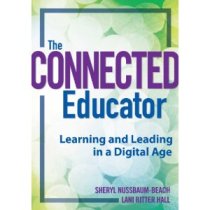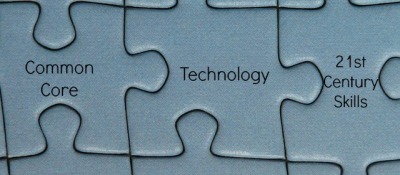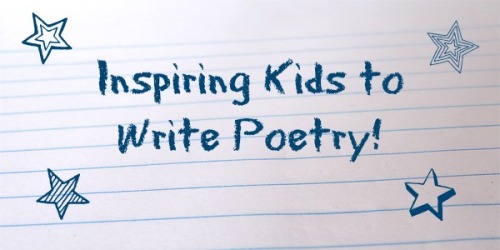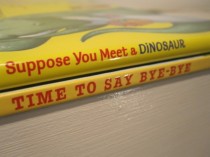I recently started the Connected Educator by Sheryl Nusssbaum-Beach and Lani Ritter Hall. I’ve been fortunate enough to  take ecourses from both of them through Powerful Learning Practice. They have both inspired and supported me in so many ways, so I was very excited to read their book.
take ecourses from both of them through Powerful Learning Practice. They have both inspired and supported me in so many ways, so I was very excited to read their book.
After completing the first two chapters one thought that kept going through my mind is that all preservice teachers should be reading this book. It sets it up so clearly what it means to be a connected educator and how important it is to be a part of multiple communities. I can think of many instances in my first year of teaching that I would have liked to turn to a personal learning network for support and ideas especially because I was still getting to know many of my colleagues and building relationships. (Don’t get me wrong, I had incredibly supportive coworkers, but when I was still building trust, I didn’t always feel comfortable asking certain questions.)
One aspect of the first chapter that has really hit home for me is the DIY mentality that Sheryl and Lani talk about. I took some time off from education to be with my son, while I had the best intentions to stay on top of things, being a new parent became my main focus for a while. Now that life has calmed down a bit and I’ve rediscovered my passion for education, all of my learning has been DIY. I try to get on twitter at least once a day, I’ve been reading blog posts again and I’ve signed up for several newsletters, all of these things have helped me catch up and stay current with all that is going on.
Throughout reading Chapter 4, I found myself highlighting and agreeing with a lot of it. The main focus of this chapter is building relationships and how important they are if we want to begin to change our schools. This one quote really struck me, in a section talking about making changes, how it affects us to let go of a practice and the importance supporting one another:
“Working in teams ensures that individual issues are addressed rather than ignored often without putting at risk the speed of adoption, morale, or achievement. Make time for members in your learning community to talk through and adjust to change initiatives and the transformation taking place in order to build a community that will last and be effective.”
This is so important and I think it is a vital part of the process that gets forgotten when changes are being  implemented. Many times teachers are told how they have to change their teaching practice and how they feel about this change is not considered or addressed.
implemented. Many times teachers are told how they have to change their teaching practice and how they feel about this change is not considered or addressed.
Another aspect of this chapter that I thought was really important was the idea that if we want our students to be connected global citizens, we have to model this for them. I think this was an area I fell short of when I was working through my teaching transformation and I’m sure if I was still in the classroom I would be working towards this. Our connections as teachers give our students ready made connections in a safe network. By showing them how we built trust with our PLN, we are modeling safe relationships and the power of reaching out and making connections.
As I read chapter 5 I was introduced to a tool that I haven’t used before and other ways I could expand the uses of tools I use already. I found Sheryl and Lani’s advice very practical and Sheryl makes a great point when she says:
“However, I feel it is a disservice to children when educators become so enthralled with the tools that they lose sight of what is most important-the learning. Our focus should always be on what we can do with the tool. Tools should be used to serve the learning. Blink, and online tools change, so be careful where you invest your time.”
While this points out the importance of mindfully using tools, for me it also brings up the importance of teaching students how to be adaptive, tools are constantly changing. We don’t know what tools our students are going to be using years from now. This is the primary reason I introduced new tools to my student by letting them explore and learn on their own. I would do a short quick lesson on the main points and then give them time to play.
The last few chapters focus on creating a learning network and community for yourself and your school. They realistically bring up all aspects of developing a Connected Learning Community, and how you can push past obstacles and encourage the development of this community. The advice and resources come from Lani and Sheryl’s direct experience with building and supporting Connected Learning Communities, so you know it has been successfully applied in real situations.
In the beginning of this post I said all preservice teachers should read this book, after completing the book, I think anyone involved in education would benefit from reading this book. For teachers there is practical advice on growing their network and how they can use that network to support their teaching. The activities at the end of each chapter ease the reader into becoming a Connected Educator and help educators that are new to the tools feel comfortable with exploring. For administrators and leaders, the final chapters are key in supporting the development of a Connected Learning Community. If you’re looking to change the culture of your classroom or school, this book will be a valuable tool!







 make sure our poetry lessons were interactive and creative. While we did learn the different forms of poetry, I also incorporated activities that allowed the students to write poetry without any requirements, where they either wrote free form poetry or chose a form that they enjoyed. I wanted them to see that poetry was a creative and personal process.
make sure our poetry lessons were interactive and creative. While we did learn the different forms of poetry, I also incorporated activities that allowed the students to write poetry without any requirements, where they either wrote free form poetry or chose a form that they enjoyed. I wanted them to see that poetry was a creative and personal process.

